
In Canada, some 54 native species (7 or 8 reaching tree size) are known, plus numerous forms of subspecific rank. Identification is complicated because plants are dioecious (ie, male and female flowering catkins occur on different plants) and the catkins frequently appear before the leaves. Leaves are simple, alternate and usually long and pointed; flowers are petalless. Distribution is transcontinental; some of the smallest woody plants, eg, dwarf willow (S. herbacea), extend the genus range to the High Arctic. Introduced species include the large, popular weeping willow (S. babylonica). Willows are widely grown for ornament, as shelterbelt plantings, and sometimes for waterside erosion control. The tough, flexible young branches are wickerwork material (osier). Like the ancient Greeks, Canadian Indians used the bitter inner bark, which contains salicylic acid, as a painkiller and to reduce fever. Although the wood is soft, it is used by artisans in the weaving and crafting of rustic furniture.

 Share on Facebook
Share on Facebook Share on X
Share on X Share by Email
Share by Email Share on Google Classroom
Share on Google Classroom


